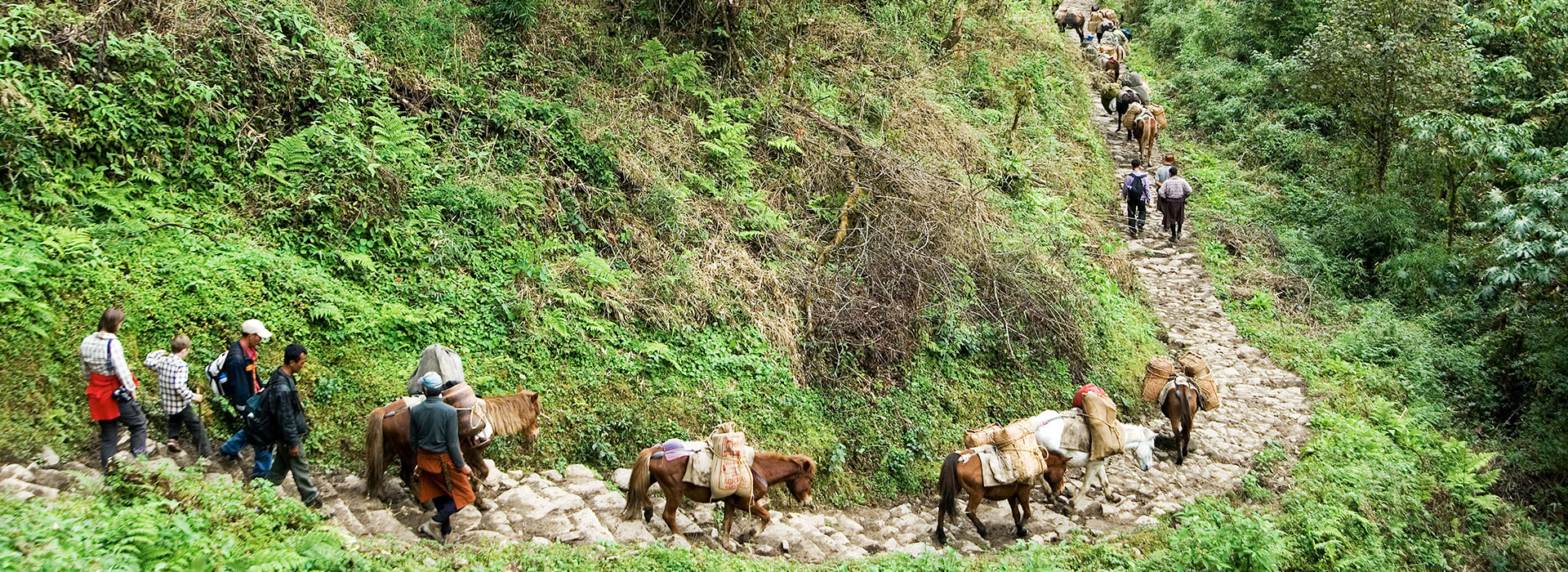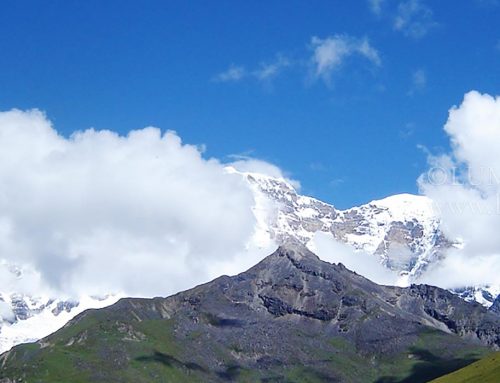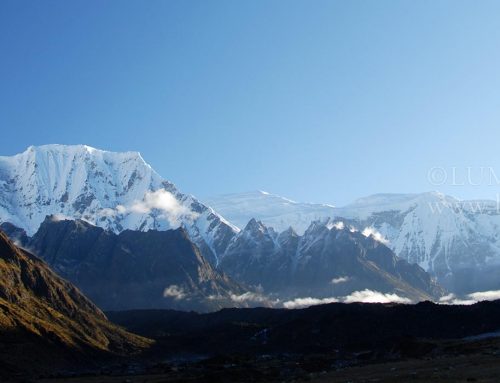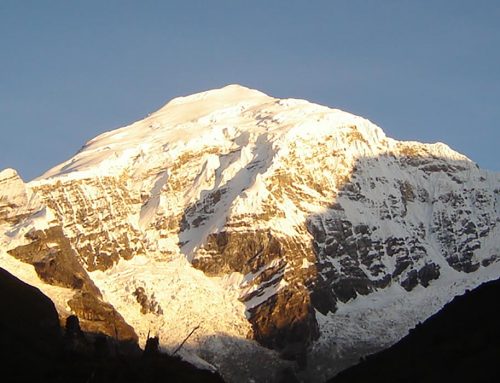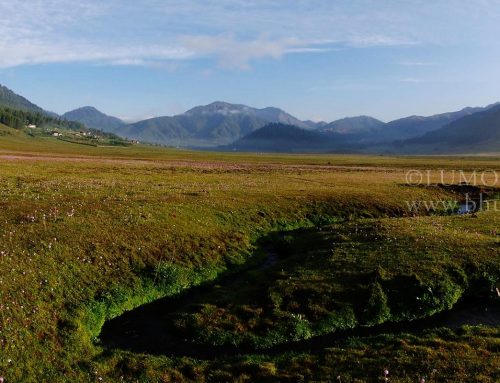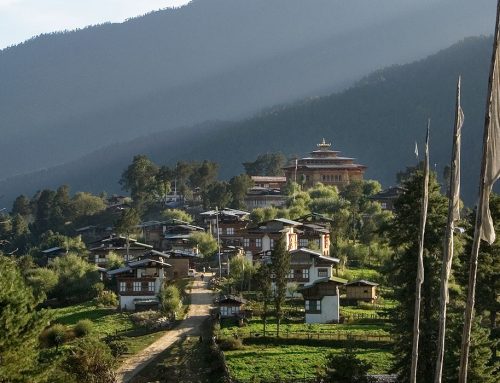- Duration: 19 nights / 20 days.
- Accommodation: Hotels, Resorts and Tents.
- Activity Type: Walking, Trekking & Tour.
- Difficulty Level: Strenuous.
- Highest Point: 4115 meters.
- Group size: Minimum 2 pax
- Best Months for the Trek: March – May, September – 2nd Week of December.
- Spectacular view of Mount Jhomolhari (7314m)
- Opportunity to witness diverse flora and fauna
- Opportunity to spot the blue sheep
- Experience the unique culture of Laya people
- Excursion to the famous Taktsang – “The Tiger’s Nest”
- Opportunity to take bath in a natural hot spring pond in Gasa
- Visit to Drugyal Dzong – The ruins of Victory Fortress, built in1644.
- Visit to Kichu Monastery, built in the Seventh Century
- Visit to Memorial Chorten, the Buddha Statue, Punakha Dzong, and Chimi Lhakhang – “The Temple of Fertility”.
DAY 01. ARRIVE AT PARO, 2280 METERS, BY DRUK AIR:
The flight into Paro is a befitting introduction to the spectacular beauty of Bhutan. In clear weather, you will be able to see some of the world’s highest peaks as you fly into Paro. As the aircraft prepares for landing, you will be surrounded by the lush green valleys. On landing, your Bhutanese escort from Druk & Drukpa Travel will greet you at the exit terminal, and then drive you the short distance to the Hotel. In the evening, you are free to stroll in the town for photography. Overnight in a hotel.
DAY 02. PARO, 2280 METERS:
After breakfast you will visit the Ta Dzong, an ancient watchtower, now the National Museum. Just below the Museum, sitting atop a knoll is the Paro Rinpung Dzong, the center of civil and religious authority of Paro district. You will cross a beautiful cantilever bridge to the base of the dzong. A short distance further is one of the innumerable archery ranges (archery is the National Sport of Bhutan). If we are lucky, we may catch a match in action.
After lunch, we will drive you to the ruins of the Drukgyal Dzong (Victory Fortress) about 16 km away from Paro town. Built in 1647 by the great Shabdrung Ngawang Namgyel, father and unifier of medieval Bhutan, the dzong was destroyed by fire and has been in ruins since then – an evocative reminder of the great victories it was built to commemorate. On a clear day you will see an unforgettable view of Mt. Jhomolhari (7,314 m), the highest unclimbed peak in the world. On the way back, visit Kichu Lhakhang that was built in 659 AD by the Tibetan King Srongsen Gampo. In the evening, you are free to stroll in the town. Overnight in a hotel.
DAY 03. PARO, 2280 METERS: EXCURSION TO TAKTSANG MONASTERY:
After breakfast a short drive will take you to Satsam Chorten, from where you start your 2-hour hike to view the spectacular Taktsang (Tiger’s Nest) monastery. The trail climbs through beautiful pine forests. You will stop for a rest and light refreshments at the Taktsang Zakhang (cafeteria) and then walk a short distance until you see, clearly and seemingly within reach, the famed Taktsang Monastery. Built in the 1600s, this incredible monastery clings to the edge of a sheer rock cliff. It is said that Guru Padmasambhava, the tantric mystic who brought Buddhism to Bhutan, came to Taktsang riding on a tigress. Lunch will be served at the cafeteria, followed by the walk back to Satsam Chorten. In the afternoon, you will visit Tachog Lhakhang and a Bhutanese Farm House. Overnight in a hotel.
DAY 04. PARO – SHANA (START OF TREK):
Trek to Shana starts at Drukgyal Dzong at 2580 meters following the Paro River and we pass through cultivated fields and picturesque villages. Amid melodious birdsongs, you will come across brightly colored beautiful butterflies. Overnight at camp Shana.
Altitude 2850 m; Distance 17 Km; Time 5 – 6 hours; 360 meters ascent, 80 meters descent.
DAY 05. SHANA – THANGTHANGKA:
The trail follows the river through a heavily forested area with a few isolated farmhouses. We pass a junction enroute, where another path leads north over the Tremo La to Tibet. Camp is in a meadow with a stone shelter.
Altitude 3610 m; Distance 22 Km; Time 7 – 8 hours; 770 meters ascent, 10 meters descent.
DAY 06. THANGTHANGKA – JANGOTHANG:
You will pass a small army post in the morning, after which the trail comes out of the pine forests and gradually climbs into a beautiful valley, passing Tegethang, the winter home of yak herdsmen. Lunch will be served in one of these huts. You will come across hundreds of Yaks before arriving at the Mt. Jhomolhari base camp (4,115 m). High mountains overlook the camp and visible nearby are the ruins of an old fortress used to guard Bhutan against Tibetan invasions.
Altitude 4080 m; Distance 19 Kms; Time 5 – 6 hours; 480 meters ascent.
DAY 07. JANGOTHANG:
It’s a rest day at Jangothang. You may enjoy the superb view the mountains around, take pictures, and relax. We also offer day hike options:
- Hike to Jumolhari Glacier which is around 4 ½ hours (back and forth)
- Hike to Jichu Drake Glacier which is around 3 hours (back and forth).
- Walk up the mountain between Jumolhari and Jichu Drake, the summit is at 5200 meters with a great view of both the mountains. This is 8 hours (back and forth).
DAY 08. JANGOTHANG – LINGSHI:
A good day’s walk today with spectacular view of Mt. Jhomolhari, Jichu Drake and the Tserim Gang. You will start climbing straight away and after some 3 to 4 hours reach the Nyelela Pass (4,700 m). You will then descend to a circular hut just below Lingshi, where we camp. You will be able to see the truly mystical Lingshi Dzong atop a high hill.
Altitude 4000m; Distance 17 kms; Time 6 – 7 hours.
DAY 09. LINGSHI – CHEBISA:
A gentle climb from Lingshi will take you to another delightful village, Gom Yu, located below a 300 m cliff. Another one hour’s walk will see us in a lovely little valley with a huge waterfall by the village of Chebisa, where we will camp by the riverside.
Campsite altitude 3880m; Distance 10 kms; Time 5 – 6 hours; 280 meters ascent, 410 meters descent.
DAY 10. CHEBISA – SHOMUTHANG:
You will start the day with a steep climb through high pastures up the Gokula Pass (4320 m) before descending through forests of dwarf rhododendron. Then you make a short climb and head down to the camp near a riverbed.
Campsite altitude 4220m; Distance17kms; Time 6-7hours; 890 meters ascent, 540 meters descent.
DAY 11. SHOMUTHANG – ROBLUTHANG:
From Shomuthang it is a long haul over the Jarela pass at 4,640 m where you will once again come across the stunning views of the Himalayan Mountains. We drop steeply down a forest trail to the Tsarigathang valley, where herds of Takin roam, then cross a knee-deep river before climbing up Robluthang where we camp.
Campsite altitude 4,160m; Distance 18 kms; Time 6 – 7 hours; 700 meters ascent, 760 meters descent.
DAY 12. ROBLUTHANG – LEMITHANG:
This is one of the hardest days of the trek. You will climb slowly up to Shinchela Pass at 4870 m and will be rewarded with a stunning view of the Himalayan Mountains, including the spectacular Gang Chen Ta at the head of the valley. On a clear day all the mountains on the northern border are visible. Eagles, griffin vultures, blue sheep, and yaks abound in this area. We then descend to camp on a lovely spot by the riverbank.
Campsite altitude 4140 meters; Distance 19 kms; Time 6-7 hours; 850 meters ascent, 870 meters descent.
DAY 13. LEMITHANG – LAYA:
You will walk along the river, one of the tributaries of the Mochhu, and through a forest of rhododendron and silver fir and then enter the village of Laya. The people of Laya are famous for their clothing made of yak hair and their conical bamboo hats. The women sport long hair and wear turquoise and jade. You will spend the rest of the day is spent at leisure visiting farm houses and mixing with the locals.
Campsite altitude 3840m; Distance10 kms; Time 4-5 hours; 60 kms ascent, 340 meters descent.
DAY 14. LAYA (HALT):
You will have the entire day to meet the local people and learn about their customs and tradition. You may also take pictures. From Laya you see a stunning view of Mt. Masangang.
DAY 15. LAYA – KOENA:
The trail runs along the river valley offering breathtaking view of the river, feeder streams, and waterfalls. Overnight in a camp.
Campsite altitude 3050 meters; Distance19 kms; Time 6-7hours; 260 meters ascent, 1070 meters descent.
DAY 16. KOENA – GASA TSACHU:
You will gradually climb up to Balela Pass at 3740 m and then descend to Gasa village. You will see the Gasa Dzong perched on the hillside over the village. You will then drop steeply down to the river for an hour and camp near the Hot Spring. You will have a chance for a good hot soak in the ponds.
Campsite altitude: 2638m; Distance 14 kms; Time: 6-7hours; 900 meters ascent, 1710 meters descent.
DAY 17: GASA TSACHU – GOEN DAMJI – PUNAKHA (END OF TREK):
As you descent, the last day of your trek takes you through the rolling hillsides across fields, villages and forests of oak and pine. The trail descends from the highlands above the Mochu into a lush semi-tropical gorge filled with banana trees and creepers. You might even spot a monkey. Our vehicle will pick you up at Damji and drive you to Punakha, two hours away. Overnight in a hotel.
Gasa – Damji (18 kms); 5-6 hours; 470 meters ascent, 280 meters descent.
DAY 18. PUNAKHA – THIMPHU:
After breakfast, you will visit the Punakha Dzong built in 1637 by Shabdrung Ngawang Namgyal and located between Pho Chu and Mo Chu. Punakha is the old capital. Punakha is still the winter residence of Je-Khenpo. Bhutan’s first Parliament was also convened here in 1952. After lunch, we will drive you to Thimphu, about 72 kms away, and en route you will visit Chimi Lhakhang, also called Temple of Fertility, built by Lama Drukpa Kuenley in 17th century. Overnight in a hotel.
DAY 19. SIGHTSEEING IN THIMPHU:
The day begins with a visit to the National Memorial Chorten (1974) built in honour of the late King Jigme Dorji Wangchuk and the Dupthop Lhakhang, one of the few surviving nunneries in Bhutan. We then visit the National Library and the Painting School where traditional art is still kept alive through instructions in the art of painting Thangkas (sacred Buddhist scrolls).
After lunch, you will pay a visit to the tallest Buddha statue in the world and witness an archery match. Other highlights in Thimphu include a visit to the Tashichhodzong, seat of the government and the Central Monastic Body, and a visit to the Handicrafts Emporium where you may buy Bhutan’s legendary handicraft/souvenir items. Overnight in a hotel.
DAY 20. DEPARTURE:
Early morning drive to the airport and farewell.
Optional activities that you can add in the program:
- Hike to Jumolhari Glacier, around 4 ½ hours (back and forth)
- Hike to Jichu Drake Glacier, around 3 hours (back and forth)
- Walk up the mountain between Jumolhari and Jichu Drake, the summit is at 5200 meters with a great view of both the mountains. This is 8 hours (back and forth)
- Excursion to Chelela Pass
- Rafting in Pho Chu (Punakha)
Cost inclusive of:
- All Meals [Breakfast /Lunch/Dinner]
- Accommodation [Twin Sharing] Single Room Supplement Extra US $: 40 per room per night.
- All transportation within the country including airport transfers.
- Royalty & Govt. Taxes
- Entrance fees for Museums and Monuments only
- Visa Fee
- Airport tax
- Contribution to Tourism Development Fund
- Guide
- Sightseeing
While on trek, cost covers:
- Nature Recreation and Ecotourism Division (NRED) Nu.1000
- 3 meals a day
- Service of cook & helper
- Guide, sleeping tent
- Mess Tent, Kitchen Tent & Toilet Tent
- Ponies to carry supplies
- Royalty
- We will provide you with sleeping mats but you have to bring your own sleeping bags.
Cost exclusive of:
- Druk Air fare
- Insurance Premiums
- Payments for service provided on a personal basis
- Cost for any services not mentioned in the “Cost Include Head”
- Cost incurred due to mishaps, strikes, political unrest, etc.
- Personal expense in items such as laundry, soft drinks, camera charges, bottled water, incidentals, portage, bellboy charges, tips or any other services
Personal clothing: strong normal clothing (according to season). Preferably cotton, even for summer, woolen clothing for the evening and winter.
For Trekking, one must bring:
- Strong comfortable trekking boots – water-resistant for the rainy period of June-August
- Sunscreen
- Flash light
- Rain coat (especially for rainy period – June-August)
- Head gear/hat/cap for sun and rain protection
- Water pills – for extra caution in purifying stream; (boiled water is provided at all times during the trek)
- Aspirin – incase of altitude sickness
- Lots of socks
- Warm clothes
OPTIONAL ITEMS
- Sunglasses
- Headgear
- Folding umbrella (only for wet months — July and August)
- One towel
- Pillow case
- Wet-packed tissue paper
- Pillow


